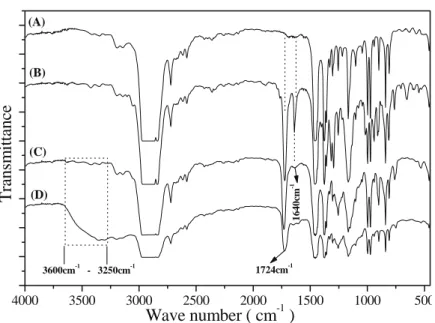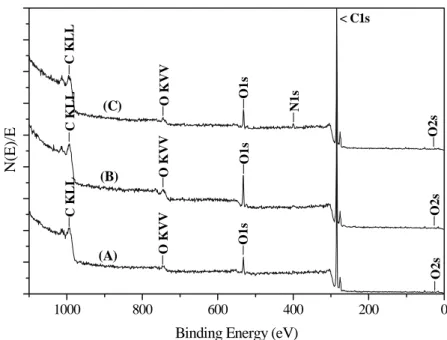ISSN 0104-6632 Printed in Brazil
www.abeq.org.br/bjche
Vol. 23, No. 02, pp. 267 - 271, April - June, 2006
Brazilian Journal
of Chemical
Engineering
POLYPROPYLENE GRAFTED WITH GLYCIDYL
METHACRYLATE USING SUPERCRITICAL
CO
2
MEDIUM
M. H. Kunita, E. M. Girotto, E. C. Muniz and A. F. Rubira
*Universidade Estadual de Maringá, Departamento de Química, Av. Colombo 5790, CEP: 87020-900, Phone +(55) (44) 261-4332, Fax +(55) (44) 263-5784, Maringá - PR, Brazil,
E-mail: afrubira@uem.br
(Received: October 20, 2004 ; Accepted: January 5, 2006)
Abstract – Films of polypropylene (PP) were grafted with glycidil methacrylate (GMA) using supercritical
CO2 as swelling agent and solvent. Different pressures and temperatures were used to study their effects on the soaking and grafting process. FTIR results showed signals at 1726 and 1640 cm-1, assigned to C=O and C=C (after the soaking process), and a decreased signal at 1640 cm-1 (after the grafting procedure), suggesting the effective grafting of GMA. For the grafted material immersed in ethylenediamine, peaks in the 3600 to 3250 cm-1 range (N-H stretching) were evident. Contact angle measurements showed an increasingly hydrophilic nature in the direction from pure PP to grafted PP/GMA (PP-g-GMA) to PP-g-GMA immersed in ethylenediamine (PP-g-GMA/En). X-ray photoelectron spectroscopy provided evidenced of the effective incorporation of ethylenediamine in the grafted material.
Keywords: Polypropylene; Glycidil methacrylate; Grafting; Supercritical CO2 medium.
INTRODUCTION
Polypropylene (PP) has been used in many applications but, in general, its use is limited by its lack of functional groups. Thus, functionalization reactions have been used to increase its interfacial interactions (Zhang et al., 2002). The grafting process is one of the methods most frequently used to modify PP. Graft polymerization by hydrogen abstraction from tertiary carbon offers an effective approach to introducing some desirable properties into the polymer, thus expanding its applications without adversely affecting the backbone architecture (Allmér et al., 1989). Using benzoyl peroxide (BPO) as initiator and GMA as monomer, the copolymerization process occurs via a free-radical mechanism, through the scission of
UV irradiation (improving degradation stability). In similar work, Liu et al. (2002) prepared isotactic PP grafted with methylmethacrylate using supercritical CO2 and observed a decrease in
crystallinity with an increase in degree of grafting, thus indicating the optimal conditions for the grafting.
The use of supercritical fluid to prepare new materials is an interesting method, especially for supercritical carbon dioxide (SC CO2), which has
many unique properties (Liu et al., 2003) compared to conventional solvents. One of its important contributions has come from the continuing environmental pressures on industry to move away from volatile organic compounds (Taylor, L. T., 1996) and ozone-depleting substances as processing solvents, resulting in a “green” alternative for industry; this feature that was recently reviewed for supercritical carbon dioxide in the processing of polymers (Tomasko et al., 2003).
The aim of this work was the functionalization of polypropylene by a process of free radical grafting with glycidil methacrylate using benzoyl peroxide as initiator and supercritical CO2.
Moreover, we studied the main factors involved in the grafting process and evaluated the reactivity of the GMA epoxy group after its grafting onto PP films.
MATERIALS AND METHODS
Materials
Thin films of PP (50 µm, supplied by Poliolefinas Co., Brazil) were cut into 3 x 4 cm pieces, extensively washed with acetone (Merck) for 12 h (Soxhlet), dried at 80 oC for 4 hours and kept in vacuum. Glycidil methacrylate (GMA, Aldrich) and the initiator benzoyl peroxide (BPO, Riedel-de-Häen) were used as received.
Grafting Process
The glycidil methacrylate was incorporated onto the PP in two steps: soaking and thermal treatment. In the first step, the PP films, GMA monomer and BPO free radical initiator were fed into a supercritical fluid vessel. The conditions studied in this step were i) a time of 4 hours; ii) a temperature
of 50 oC and iii) a pressure of 110 bar. After the soaking time, the CO2 was released and the PP films
with impregnated GMA/BPO were washed with acetone to remove the unreacted GMA. In the second step, the PP films impregnated with GMA/BPO were added to an other supercritical vessel and pressurized with N2. The system was heated and the conditions
for this grafting process were the following: a) a temperature of 115 oC; b) a time of 4 hours and c) a pressure of 50 bar. At the end of the thermal treatment the PP films were extracted in a Soxhlet using acetone for 12 hours to remove the unreacted monomer and homopolymers (Zhang et al., 1995). Soon afterwards, the samples were stored in vacuum. To check the reactivity of the epoxy ring the
samples of polypropylene-grafted-glycidil methacrylate
(PP-g-GMA) were immersed in a bath of ethylenediamine and stirred for 4 hours at 50 oC.
Instrumentation
The grafting process was carried out using Thar equipment, model SFE 500. Carbon dioxide (White Martins) 99.95% pure was used. FTIR spectra were obtained using a Bomem spectrophotometer, model MB100. The grafting reaction was monitored by Fourier Transformed IR spectroscopy (FTIR) with a BOMEM-MB100 spectrophotometer. Contact angle was measured with a TANTEC model CAM-Micro meter. X-ray photoelectron spectroscopy (XPS) measurements were obtained in a Perkin-Elmer Phi Model 5400 ESCA system with a magnesium anode (Kα = 1253.6 eV) operating at 400W.
RESULTS AND DISCUSSION
4000 3500 3000 2500 2000 1500 1000 500
3600cm-1 - 3250cm-1
16
40c
m
-1
1724cm-1
(D) (C) (A)
(B)
T
ransm
ittance
Wave number ( cm-1 )
Figure 1: FTIR spectra of (A) pure PP; (B) impregnated GMA PP film in supercritical CO2; (C)
impregnated GMA PP film in supercritical CO2, submitted to the grafting process and
(D) after immersion in ethylenediamine for 4 hours at 50 oC.
+
NH H
CH2
CH2
N
H H
CH2 CH
CH3
C O
O
CH2
CH
CH2
O
n
n
CH2 CH
CH3
C O
O
CH2
CH
CH2
HO
N H
CH2
CH2
N H H
GMA Ethylenediamine
Figure 2: Proposed reaction between GMA and ethylenediamine.
The contact angle measurements for pure PP and modified PP-g-GMA films shows a decrease from 92o±2 to 87o±1. After immersion in ethylenediamine the angle was 76o±1. These results provide evidence of the increasingly hydrophilic nature of grafted PP films.
Figure 3 shows the XPS spectra for the different samples. The results reveal subtle variations in surface composition according to the grafting process. Figure 3(B) shows an increased oxygen peak due to the incorporation of GMA. A nitrogen peak is observed in Figure 3(C) after immersion of the grafted polymer in ethylenediamine, which evinces the incorporation of amine.
1000 800 600 400 200 0
(C)
(B)
(A)
N1s
O2
s
O2s
O1
s
O1
s
O KV
V
O KV
V
C K
L
L
C KL
L
O2s
< C1s
O1s
O KV
V
C K
L
L
N(E
)/
E
Binding Energy (eV)
Figure 3: XPS spectra of (A) pure PP; (B) PP submitted to GMA grafting in supercritical fluid and (C) PP-g-GMA immersed in ethylenediamine for 4 hours at 50 oC.
Table 1: Atomic concentration on the virgin modified surfaces of PP.
Element PP PP-g-GMA PP-g-GMA/En
C1s 94.8 90.6 92.7
O1s 5.2 9.4 5.5
N1s - - 1.8
CONCLUSIONS
The PP-g-GMA graft copolymer could be prepared by free radical polymerization in the PP matrix with the aid of supercritical CO2 (SC CO2) as
solvent for GMA/BPO and as swelling agent for the PP matrix. FTIR and XPS results provided evidenced of the modification of the PP surface. PP grafted with GMA is more hydrophilic than unmodified PP. Thus, this method can be used to obtain physicochemically altered PP surfaces. Moreover, the modified material can be used to prepare composites with polymeric matrixes containing reactive groups such as amines.
REFERENCES
Allmér, K., Hult, A. and Rånby, B., Surface Modification of Polymers III. Grafting of Stabilizers onto Polymer Films. J. Polym. Sci.: Part A: Polym. Chem., Vol. 27, 3405-3417 (1989).
Espinosa, M. H., Del Toro, P. J. O. and Silva, D. Z., Microstructural Analysis of Poly(glicidyl methacrylate) by 1H and 13C NMR Spectroscopy. Polymer, Vol. 42, 3393-3397 (2001).
Huang, H. and Liu, N. C., Nondegradative Melt Functionalization of Polypropylene with Glycidyl Methacrylate. J. Appl. Polym. Sci., Vol. 67, 1957-1963 (1998).
Liu, J., Han, B., Zhang, R., Liu, Z., Jiang, T. and Yang, G., Effect of Antisolvent Carbon Dioxide on the Polymerization of Methyl Methacrylate in Different Solvents. J. Supercrit. Fluids, Vol. 25, 1, 91-97 (2003).
Liu, Z., Song, L., Daí, X., Yang, G., Han, B. and Xu, J., Grafting of Methyl Methacrylate onto Isotactic Polypropylene Film Using Supercritical CO2 as a
Swelling Agent. Polymer, Vol. 43, 1183-1188 (2002).
Characterization. J. Appl. Polym. Sci., Vol. 78, 2166-2173 (2000).
Pavia, D. L., Lampman, G. M. and Krriz, G. S., Introduction to Spectroscopy. Saunders College Publishing – USA (1996).
Taylor, L. T., Introduction to Supercritical Fluid Extraction. R&D Magazine (1996).
Tomasko, D. L., Li, H. B., Liu, D. H., Han X. M., Wingert, M. J., Lee, L. J. and Koelling, K. W., Ind. Eng. Chem. Res., Vol. 42, 6431-6456 (2003).
Zhang, J., Kato, K., Yuama, Y. and Ikada, Y., Surface Graft Polymerization of Glycidyl Methacrylate onto Polypropylene and the Adhesion with Epoxy Resin. J. Polym. Sci. Part A – Polym. Chem., Vol. 33, 15, 2629-2638 (1995). Zhang, L. F., Guo, B. H. and Zhang, Z. M.,

